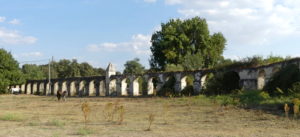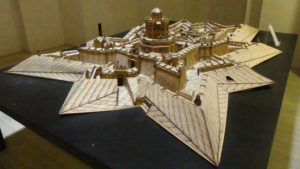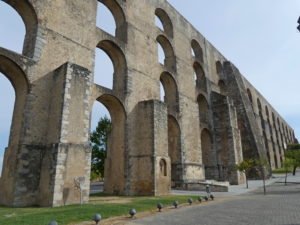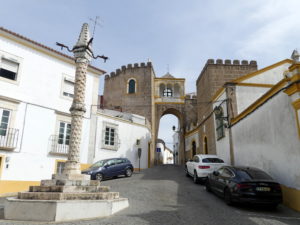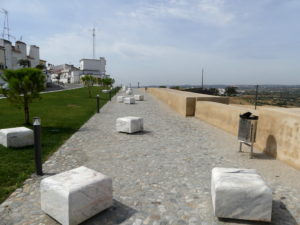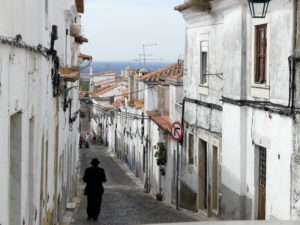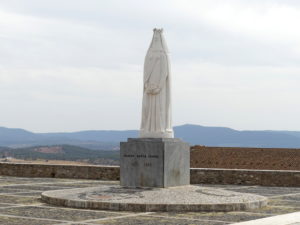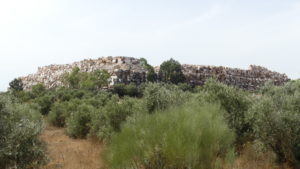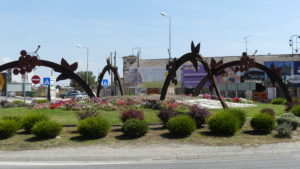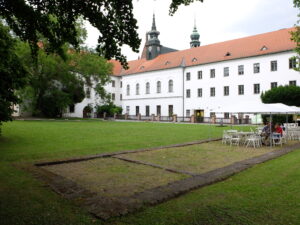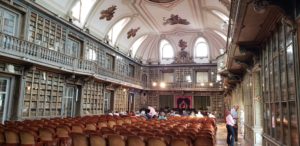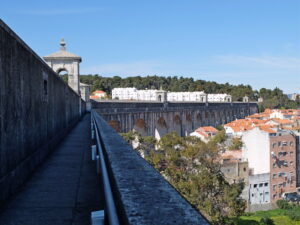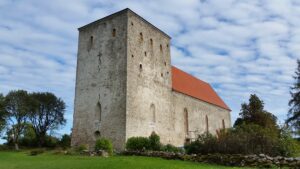In Brief: We wandered the countryside near Évora, following ancient water flow along the aqueducts, exploring historic fortress towns, and cultivating local products.
Évora
The food was delicious on the open air deck upstairs, as was the famous Alentejo wine. In Évora’s waning light, however, the star of the evening was the chunk of the multi-story aqueduct that crossed the restaurant deck just in front of us.
The entire Agua de Prata aqueduct – one of three we found in the vicinity – is impressive in itself, with some sections 26 meters (about 85 feet) high. The overall structure, which dates from the 16th century, spans nine kilometers (nearly 6 miles) and followed the same route the Romans used 1500 years earlier.

But the most appealing parts are those that have been integrated into the residential structures of the city near our restaurant. At times, the aqueduct can be tough to detect when newer buildings fit neatly into its arches.
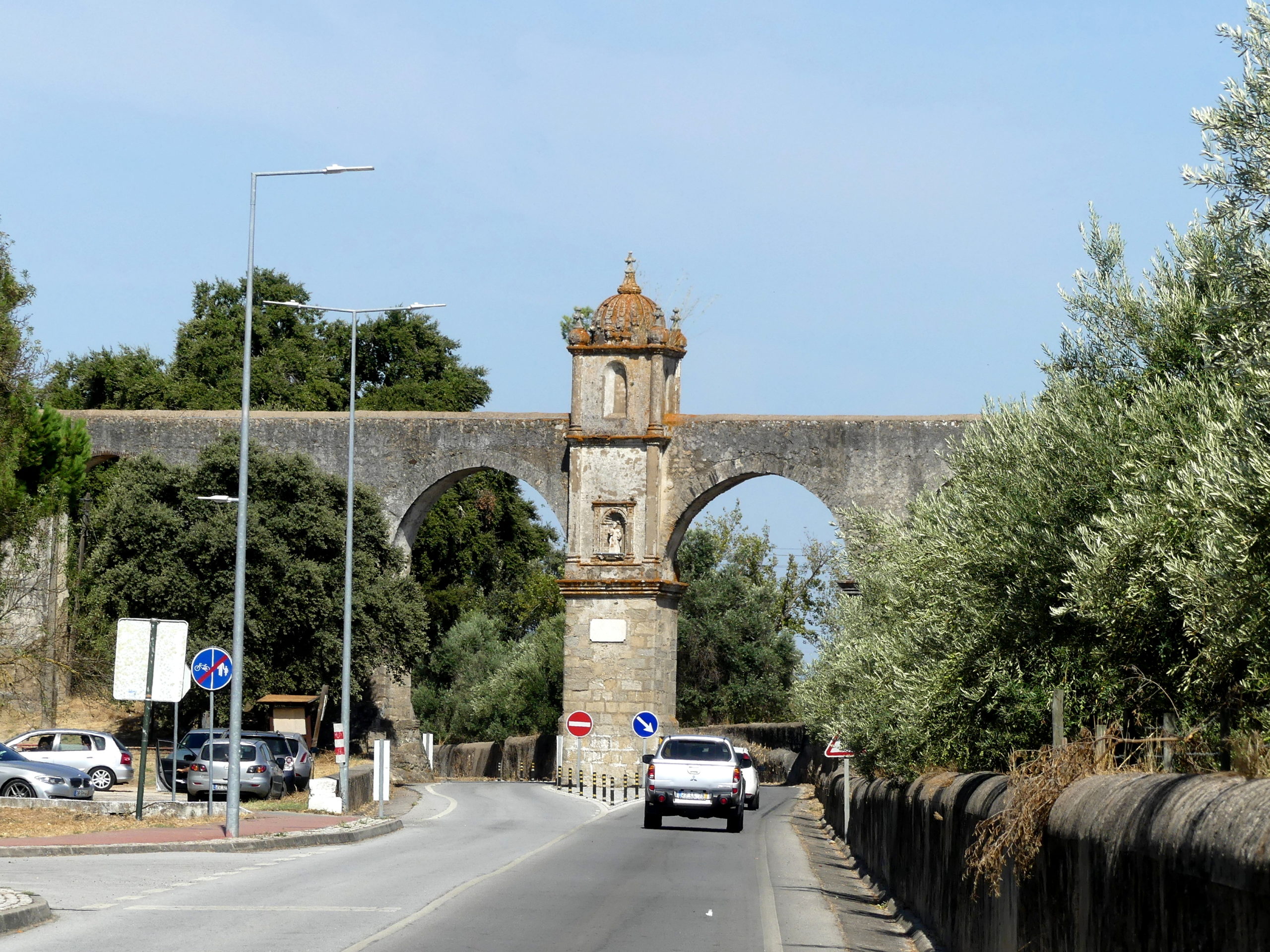
Two sections of the Évora aqueduct buttress an impressive tower in the middle of the road within a kilometer of the city walls. This section left just enough space in the spans for cars to pass through.
We also found a modest low-lying section of a separate aqueduct to the west of Évora, now supervised only by some gently grazing horses. It soon disappears underground on its way through farm country.
That was high quality water at the time, important especially in Évora to support the strategic military position of the city – and quite an expensive project. Hence, the aqueduct’s name: Silver Waters. Yet this evening, in the old aqueduct’s shadow, we happily sipped our fine local wine instead of water.
Elvas
Elvas has not left the building. Rather, the small town is the building, a fortress long shaped by wartime assaults – and one of the highlights of our Alentejo visit. It perches on a high spot near the Spanish border to the east of Évora. Even its designation as a World Heritage Site in 2012 as a “garrison border town” was based on defensive capabilities originating in the 16th century.
These included its impressive fortified walls, the vaulting aqueduct whose water let defenders outlast any siege, and the nearby hilltop forts that acted as perimeter defense posts. Those forts rank among the best preserved in Europe.
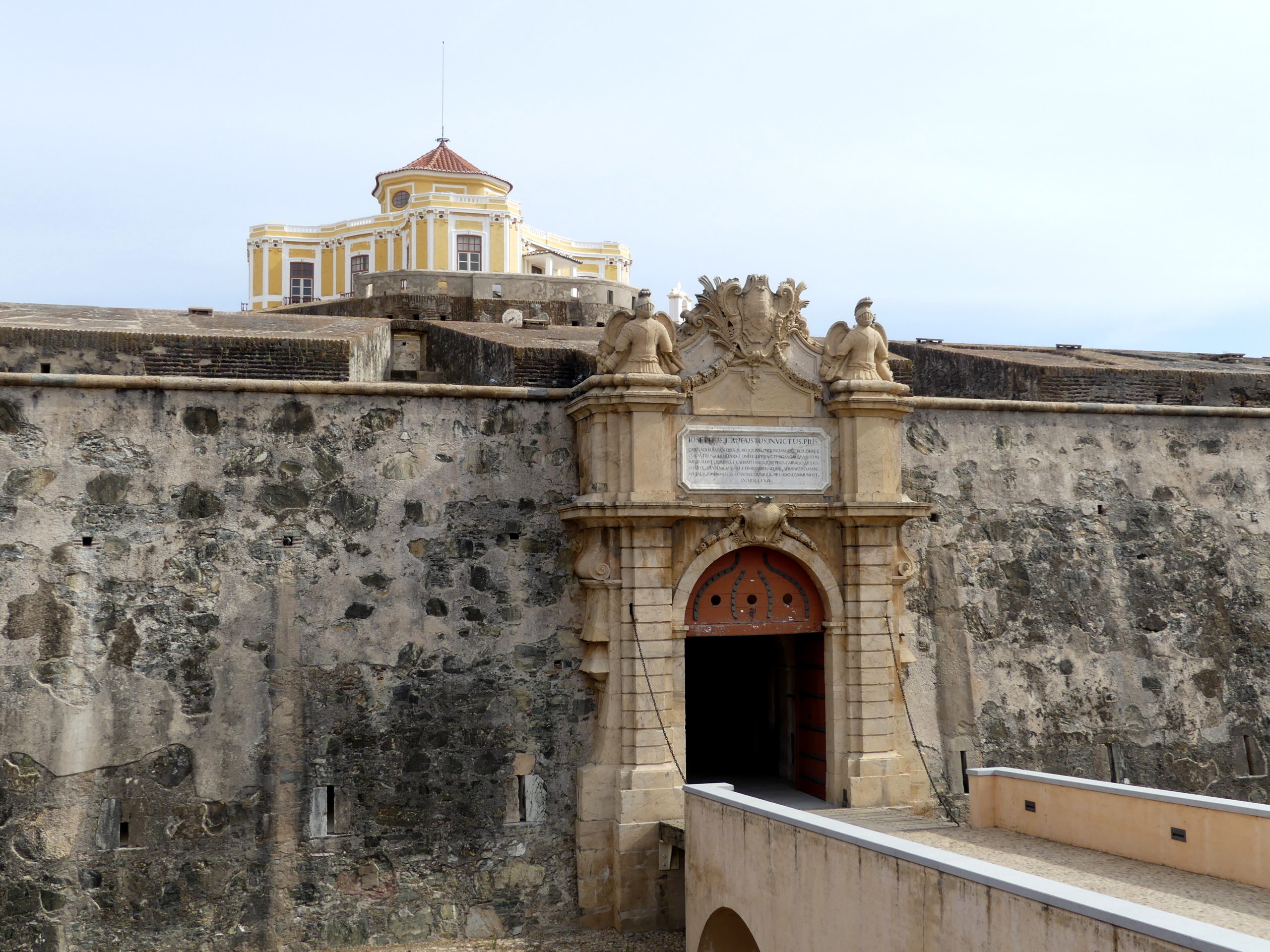
We started with the perimeter fort of Graça, atop the next hill over from Elvas. This scale model, made only of matchsticks, shows clearly the thrusting points of its star shape as well as the inner fortress and dry moats around its central keep. The formidable war machine adopted the “Dutch fort” design, as did Elvas itself, one more indication of the productive economic interchange through trade between the Dutch and the Portuguese in the 17th century. The artwork in the Évora museums showed the same historical link.
Graça is quite a showcase for the military technology of these fortifications. Its three layers of defensive walls are impressive even today, starting with this outer gateway in the star-shaped structure. Relentlessly symmetrical, Graça’s maze of hallways and rooms let us become pleasantly disoriented as we wandered about. Even the baroque central keep, which peers out over the walls and seems so close, confused us during our climb to its turret.
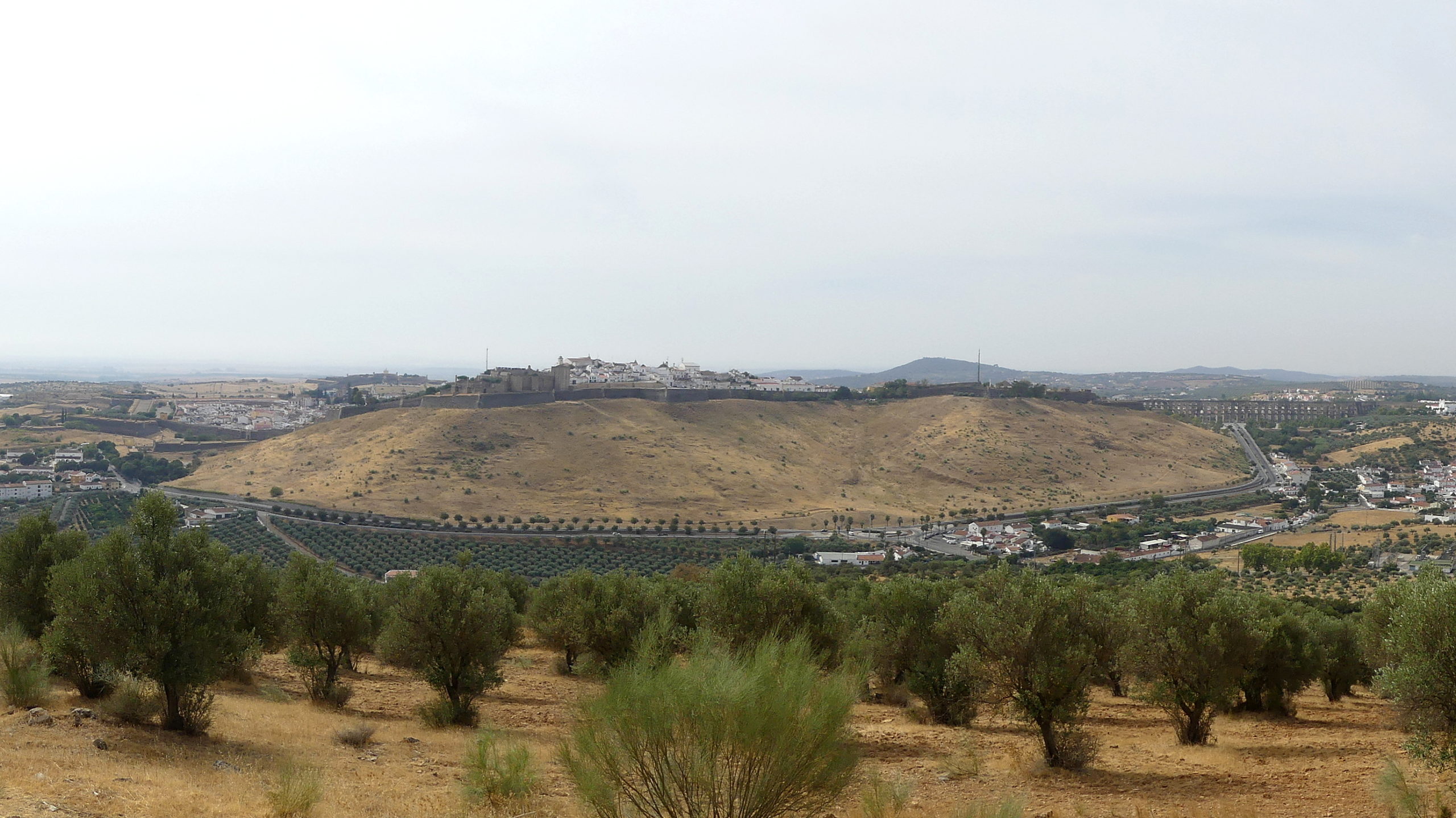
Looking back over to Elvas itself made for a grand vista across the valley. Even though Elvas’ defensive walls were also done in the “Dutch” style, it’s hard to detect the overall design from within the city. But you can see the outline of the walls from here with a careful look. Its central castle on the left is much less interesting to visit than the intricately constructed Graça fort.
To the right of the town in our view stretched its imposing aqueduct, some 40 meters (130 plus feet) tall in four tiers. For sure, the Évora aqueduct is charming. However, we were astonished at how imposing this was. And militarily useful as it supplied water to this strategically located fortress town. Though not quite so long as Évora’s, this aqueduct dominates the valley it had to cross.
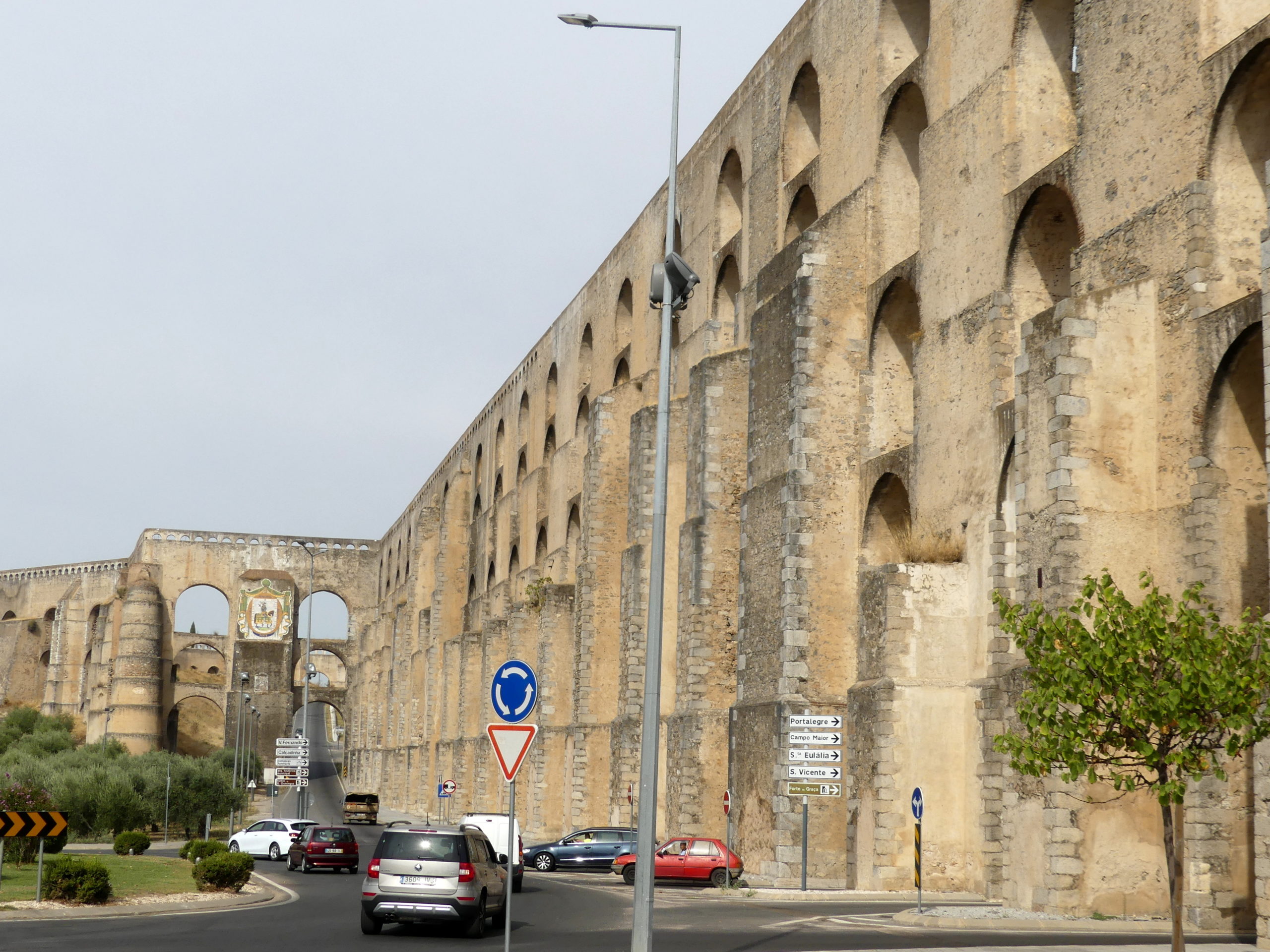
Cars look a bit like toys when they pass through its archways.
And there was plenty of conflict in this area. The Moors and the Portuguese kept displacing each other for sixty years in the 12th century. For over 150 years in the 17th and 18th centuries, the Spanish attempted fruitless sieges. But Napoleon’s forces captured Elvas for a while in the early 19th century.
Since 2012 Elvas has continued to defend itself against an onslaught of tourists. But it’s a very quiet place now that the pandemic has defeated tourism, with most of the remaining action centered on the large plaza surrounding its Cathedral.

That can be seen in this panorama, with the Cathedral in the center and some elegant buildings around the perimeter. The few open restaurants were so busy with locals and small clusters of tourists that we struggled to find a table anywhere. Here two of the tourists pose with the notable display of the town name.
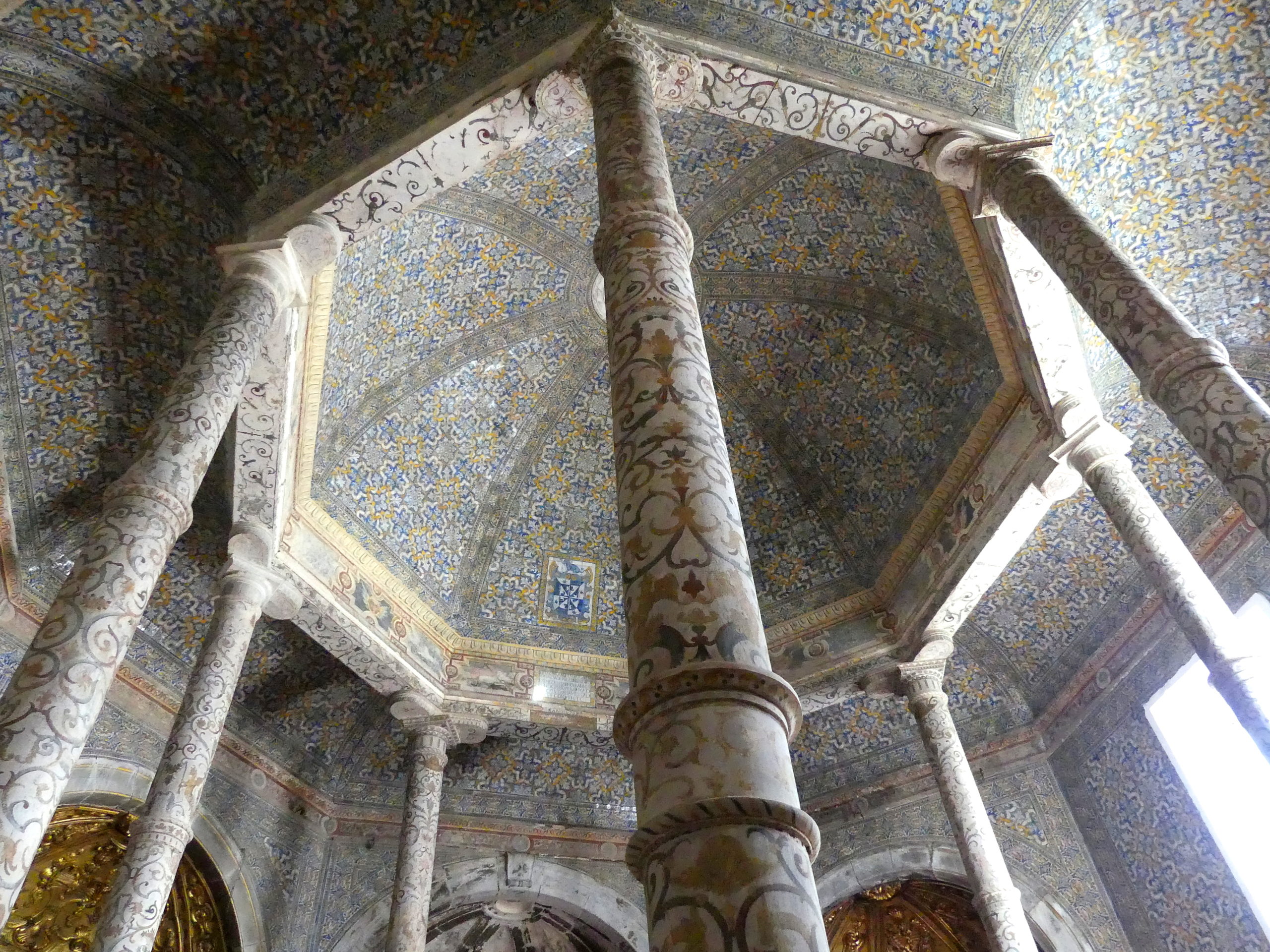
Climbing the streets uphill to the highest part of the city, we found a non-military highlight of the city, Our Lady of Consolation church. Its plain stone exterior reveals nothing about the grandeur within: the lusciously tiled interior, floral columns and hexagonal ceiling of this jewel. It replaced a similarly shaped chapel belonging to the Knights Templar.
Throughout the town, narrow streets, whitewashed buildings, and formidable walls characterize a viewing walk – along with numerous smaller plazas like this one adjacent to the gorgeous Our Lady of Consolation church. Here, a curious baroque structure perches atop the more ancient gate and stone walls. Don’t let the picturesque calm fool you. Prisoners were once chained in punishment to this ornate Manueline column.
At the highest point, with a view toward the Graça fort, we crossed along the Dutch-fort walls connecting the central plazas of the town to the old castle.
The plain stools are all made from the plentiful local marble of the area, cooling to the seat.
And a lot more to enjoy…Estremoz
In the vicinity, we visited the ancient fortified town of Estremoz, where King Dom Dinis defended the border in the middle ages.
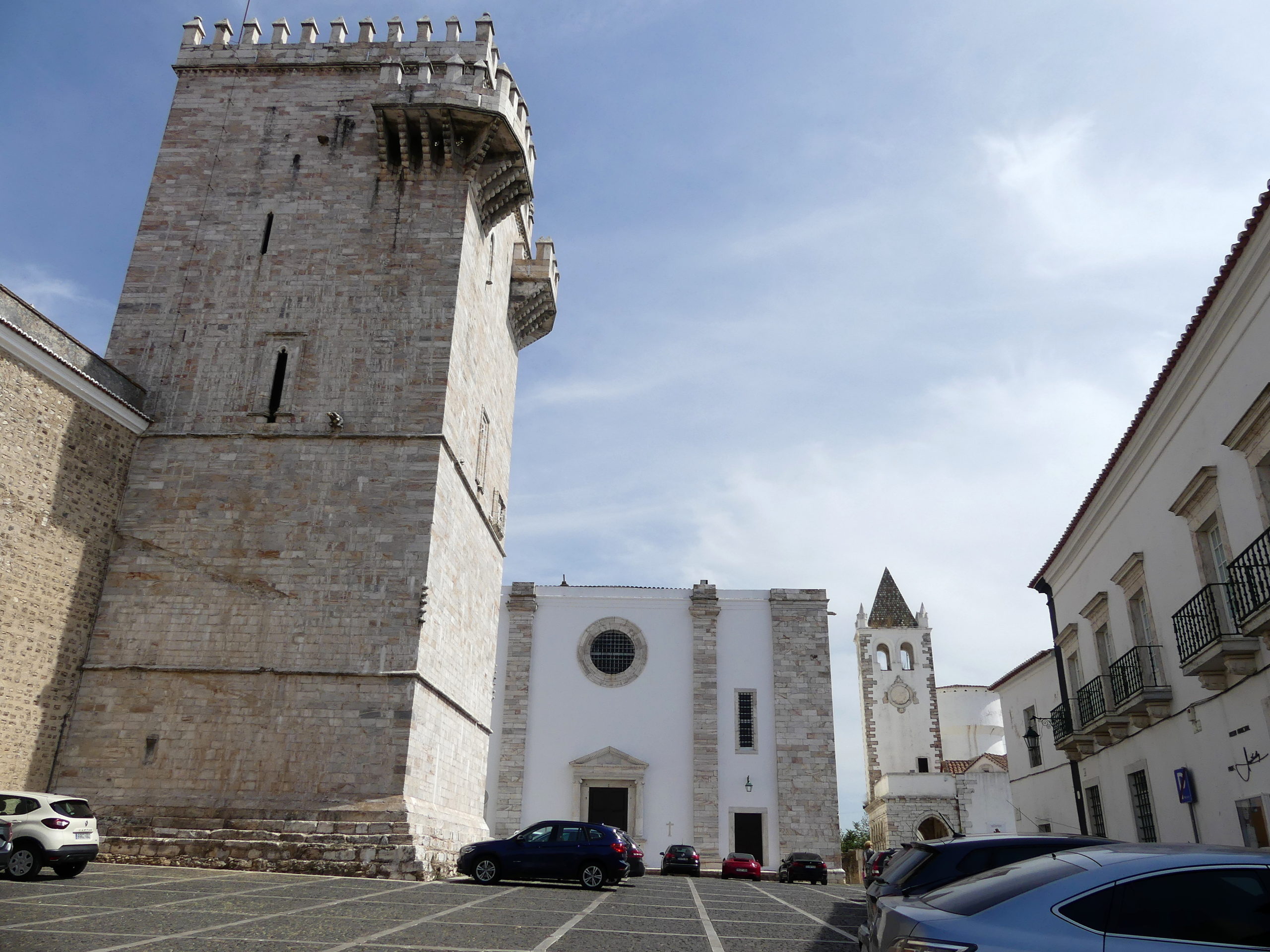
Perhaps the most impressively marbled town square out here occupies a plateau atop the walled fortress town of Estremoz. We had hoped to climb the aptly named Three Crowns tower on the left, but it was closed due to the virus. Just opposite is a noted museum of local pottery. We could have dined at some fancier restaurants still open in town, including the pousada that now occupies a palace just behind the tower.
Instead we quite enjoyed a tiny enoteca on the street leading to the square. On its one rickety outdoor table, a simpatica hostess fussed over us like a Portuguese mother pouring us some good Alentejo wine to accompany her buttery cheeses (amanteigado). As we finished, a dapper old man ambled down the central street of lower Estremoz beneath us, a dark figure amid the blanched walls.
Part of the town square of Estremoz looks far out over the hill and dale countryside. That made it an ideal defensive site for Dom Dinis. Legend says that he accused his wife, Santa Isabel, of too much generosity to the poor. This marble statue honors her as protectress of the poor, commemorating a legendary that occurred when she was questioned by him about bread she hid under her robes. When she lifted the hem, roses had replaced the bread.
Vila Viçosa
So we’re motoring along and consult our guidebook about where we are. Turned out we were entering the lovely and historically important ducal town of Vila Viçosa, whose main streets and Baroque church form a plaza of elegant buildings. Up on the tallest hill, an old castle (now become a hotel) and church look out over the town.
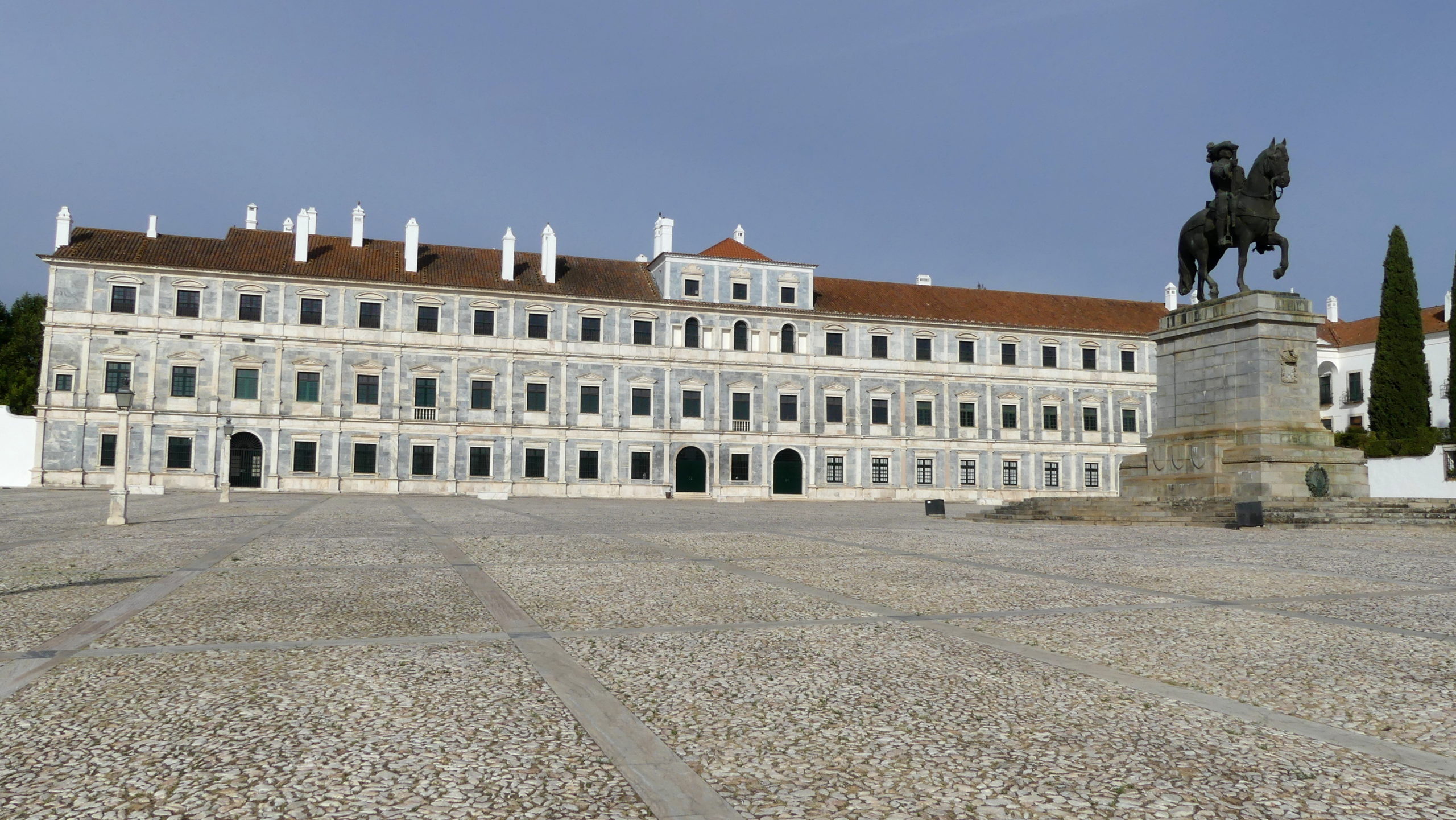
On the way out of town sprawls this ducal palace for the famed Breganza dukes who became royalty in the 17th century when they too protected Portugal from Spain. The building is all marble from local quarries and the plaza was formed from bits and pieces of the stuff.
Even now you can find extensive marble quarries in the area producing marble for numerous uses in the country, often with pieces piled up as a mountain top where someone may have lost their marbles.
The palace has long been a goldmine for historians because its huge 16th century collection of art and artefacts from global trade were inventoried at the time. The detailed inventory shows items from Mozambique, India, Malacca, China, Japan, Morocco, and Brazil – yet, more sadly, counts up the slaves who were also removed from their homeland. One of these Breganza dukes led the rebellion against the Spaniards and became King John IV in 1640. A statue of him struts in the center of the plaza. The dukedom then became the title of the heir to the throne until Portugal became a Republic in 1910. We just celebrated the 110th anniversary of that event in Lisbon.
You can’t sleep at the palace, but a ritzy pousada just to its left welcomes guests to a former convent from the 16th century.
And nature…
Across the rolling landscape of farms and hills, we also found groves of cork trees and the best of local product, the wines.
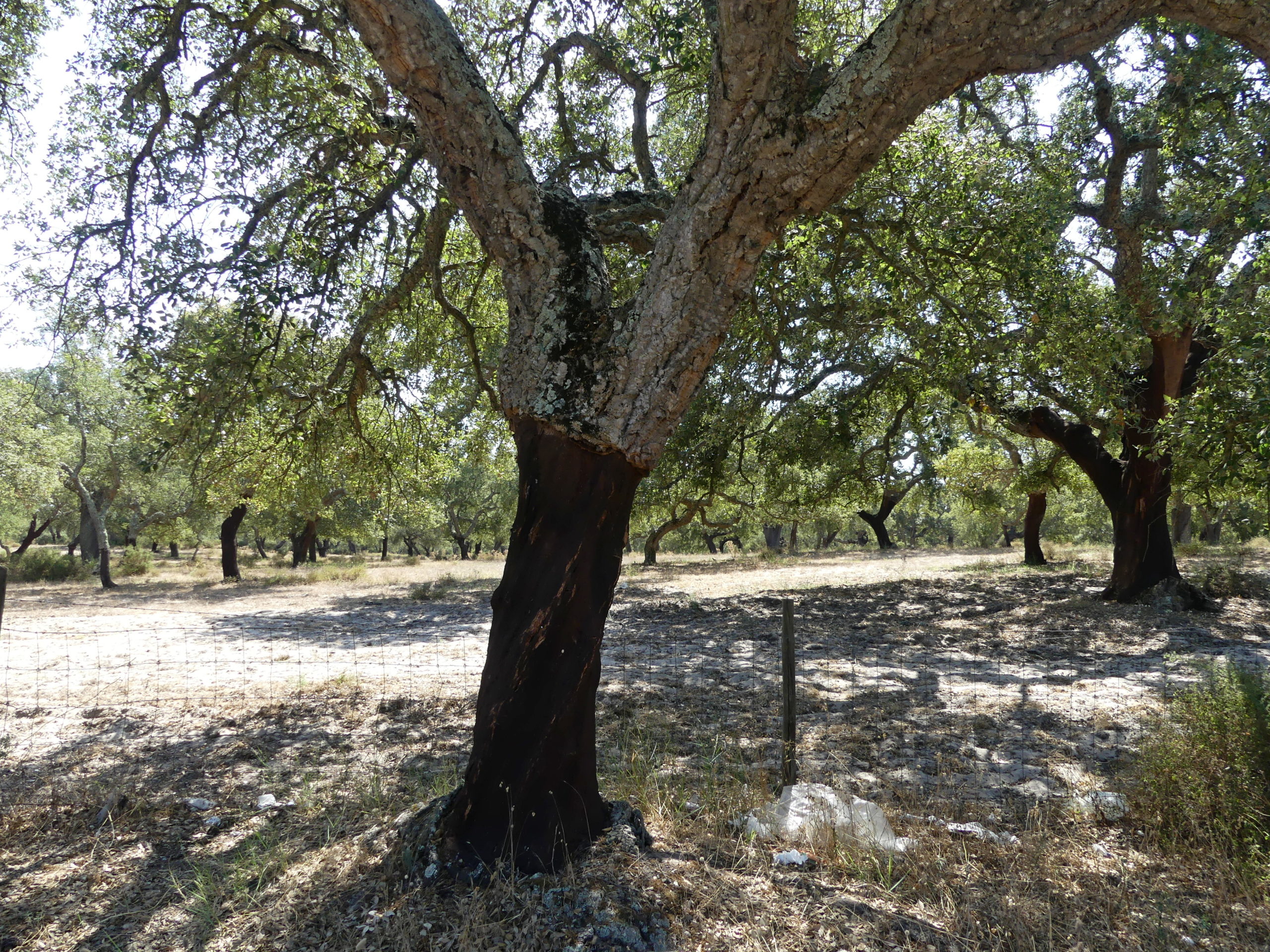
A cork oak tree, one of many in a corridor of groves running for hours alongside the roads between Lisbon and Évora. This is a big business in Portugal, not just for the obvious reason, wine bottle corks (when they are not plastic), but for other products like insulating material. And it’s all natural. The trees are stripped of their bark every seven years, but only up to about 2 meters in height – as this one demonstrates. And the quality of the cork is top grade by the third harvest, when it’s also thick enough to make wine corks. It may look like the heavy bark of other trees, but the slightly squooshy pieces are definitely cork to the touch.
The Alentejo, the area south of the Tejo River which terminates in Lisbon, is a huge swath of land between Lisbon and Spain, about a third of the country. Because it is generally dry and hot, it is one of the best of Portugal’s many wine regions, with rich reds and some fine whites. This roundabout along the way to Évora celebrates regional wine production with a wrought iron sculpture.
(To enlarge any picture above, click on it. Also, for more pictures from Portugal, CLICK HERE to view the slideshow at the end of the itinerary page.)



